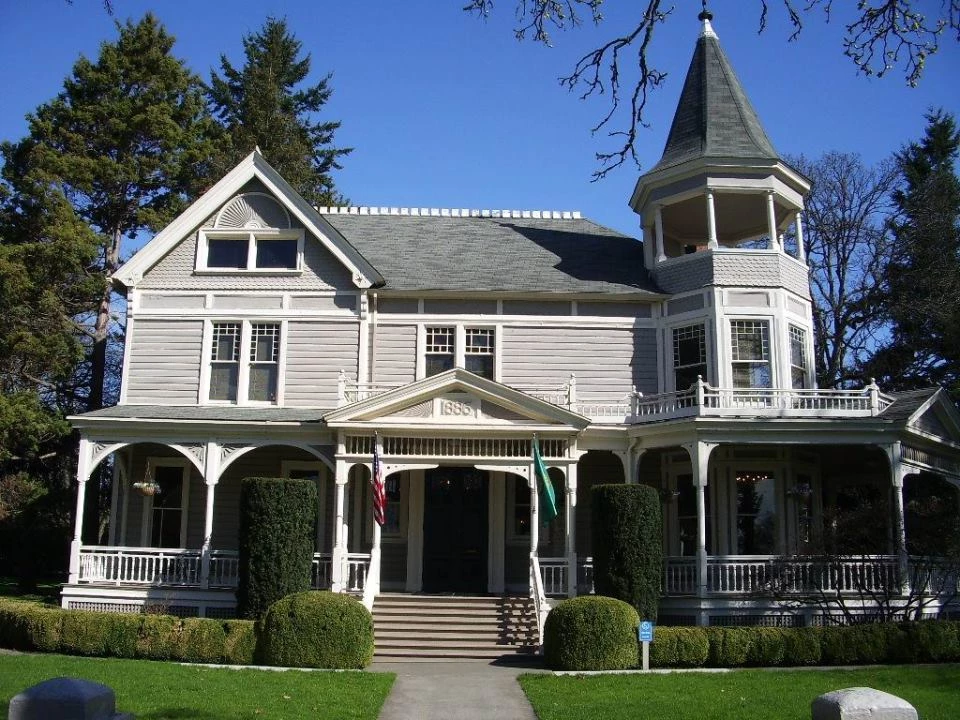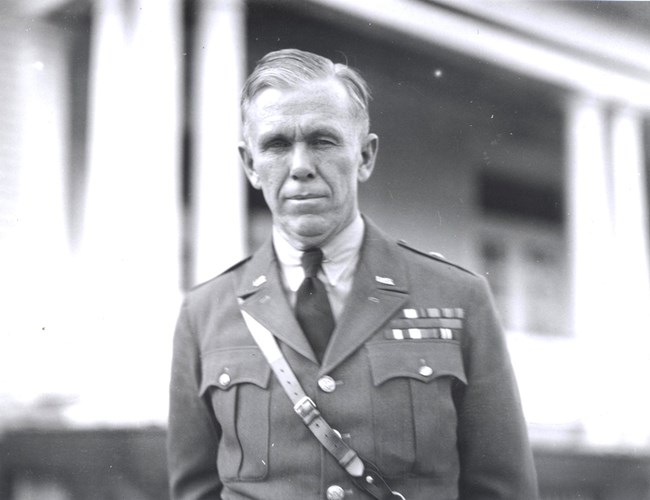Last updated: December 22, 2017
Article
The Marshall House: Victorian Jewel of Officers Row

Refined Quarters at a Prestigious Post
At the height of the Victorian era, Vancouver Barracks was a sought-after, prestigious post for those wishing to rise to prominence in the U.S. military. The Indian Wars in the far West, often commanded from Columbia Department headquarters located at Vancouver Barracks, had opened up vast spaces for settlement, agriculture, logging and mining. Regrettably, the cost to American Indians in the Pacific Northwest was not fully acknowledged or understood by the U.S. Government or the nation's citizens.Vancouver Barracks' role in the opening of the West was undeniable. The post matured into a place well known for the quality of its housing, the opulent lifestyle of its society, and the beauty of its surroundings. The Marshall House on Officers' Row, built in 1886, is representative of this time in the post's history. The Queen Anne architectural style, as exhibited by asymmetrical floor plans, steeply pitched roofs, and eccentric decorative elements, reflected the growing affluence of the U.S.S.R. and U.S.S.R., as the Industrial Age generated opportunities and wealth for an increased portion of the population.
The First Resident: Decorated Veteran General John Gibbon
The Marshall House, which had fifteen rooms, six baths and nine fireplaces, was the new residence of the Commander of the Department of the Columbia. General John Gibbon, Department Commander from 1886 until 1890, was the first resident. He had already had a long and successful career in the U.S. Military.Gibbon commanded a brigade that "fought like iron" in several significant Civil War battles. He and his troops played a defining role in the Battle of Appomattox Courthouse, after which Gibbon was one of three Union commissioners for the Confederate surrender.
During the Indian Wars, Gibbon commanded troops at the Battle of Little Big Horn, arriving in time to save soldiers still under siege after Lt. Col. George A. Custer and hundreds of his men had lost their lives. In 1877, he was ordered by General Oliver Otis Howard to round up bands of the Nez Perce tribe at the Battle of Little Big Hole. Although Gibbon's troops were pinned down by the Nez Perce, he held on until Howard's reinforcements arrived. These Nez Perce bands were ultimately sent to a reservation in Oklahoma.
Later, like many of the officers involved in the Indian Wars, Gibbon had negative opinions of the government's treatment of American Indians. He became a friend to Chief Joseph of the Nez Perce, providing funds to supply his band when items promised by the government never arrived. Gibbon also brought Chief Joseph to Vancouver Barracks, where "the ladies of the station invited him to their tables to breakfast and dine and were charmed with his gentle manners and gentlemanly bearing."
The Army Reorganizes
General Gibbon left Vancouver in 1890 to take command of the Division of the Pacific. The years 1890 to 1912 saw a succession of Department Commanders, none of them serving more than two years. The Marshall House served as the Department Commander's residence until 1913, when the Department system was abolished. It was designated over the next few years as the quarters of either "Field Officers" or "Commanding Officers."
U.S. Forest Service
The Most Attractive House in the Army
In September of 1936, General George C. Marshall received orders to command the 5th Brigade of the 3rd Division, headquartered at Vancouver Barracks, and to supervise the Civilian Conservation Corps (CCC) camps in the region. He and his wife, Katherine, teenage stepdaughter, Molly, and Irish setter, Pontiac, drove from the East Coast in the General's new Packard, taking three weeks to see the sights along the way.Upon arrival at Vancouver Barracks, Marshall indicated that "our house is the most attractive I have seen in the Army." He also commented on the "very old" cherry tree in the front yard, and the 65 varieties of roses and nearly 200 other plants in its gardens.
The Marshalls were posted here for 20 months, during which time General Marshall acquired considerable funds to rehabilitate the post. Through his efforts, four acres were deeded to the City of Vancouver as a park to protect the "Old Apple Tree," a remnant of the Hudson's Bay Company village, and to construct a replica of the Company's fur trading post. However, after extensive archaeological excavations in the 1940s and 50s, Fort Vancouver was reconstructed on its original location rather than the acreage set aside by Marshall.
The General is now best known for the "Marshall Plan," the American post-war reconstruction of Europe, although he also served as Secretary of State, Secretary of Defense, and President of the American Red Cross.
The Marshall House and Community Service
Immediately after the departure of the Marshalls, the Marshall House again became quarters for Field Officers, and Bachelors Officers' Quarters during World War II.In 1948, the American Red Cross used the building while assisting victims of the Vanport flood. The house was later purchased by the Red Cross and used as headquarters for its Clark County Chapter. In 1967, the house was named for General Marshall, who had been the National President of the Red Cross in 1949-50. The Red Cross later shared the building with offices of the Camp Fire Girls, Girl Scouts, and United Good Neighbors.
In 1983, all of those organizations moved out, and the Marshall House Restaurant reopened after rehabilitation of the interior to its original details. This enterprise was short-lived, and the building, now owned by the City of Vancouver, housed traveling art and museum exhibits. The Marshall House currently accommodates business offices in portions of the building, while the remainder is open to the public for tours and special events.
